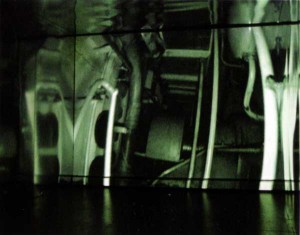For ‘Tema Celeste’ magazine

A low light bobs along a gangway in the belly of an abandoned cruise liner accompanied by the sound of heavy breathing and footsteps. It could be a scene from the film Ghost Ship, but it’s a video installation by Robert Wogan, featuring footage from the lower decks of the decommissioned SS United States. The artist made his way through room after room of mechanical apparatus, filming a journey that never seems to end. In a loop lasting just under an hour, Below (United Radiance) perfectly recreated the experience of being lost, complete with a sense of deja vu. It also documented a fall from glory by what was once the fastest and largest ship in the world.
To reach the video at UCU, viewers had to wind their way through two corridors that partially recreated a more elaborate installation from the Liverpool Biennial 2002. The metal-clad gallery walls didn’t come close to reproducing the alien atmosphere of the ship, but did transport viewers into an unfamiliar environment. The video was almost immediately disorienting and at times slightly dizzying as it followed Wogan’s unrelenting progress, never stopping to explore a room or plan a route. While the scenario would be perfect for a horror movie, the artist didn’t hesitate long enough to make his footage scary. Instead, his steady march suggested that the point was not to find a way out, but to cover as much territory as possible.
As the camera delved further and further, the ship’s enormity became apparent. At over five city blocks in length, it was unsurpassed in size and speed when it embarked on its maiden voyage in 1952. Ironically, this was also the year of the first jet airliner, an innovation that essentially paved the way for the ship to go out of service less than twenty years later. Below (United Radiance) is an exploration of loss on an industrial scale, a subject that many contemporary artists explore. The uniqueness of Wogan’s project lies in his selection of an American icon that was once world-renowned, the epitome of progress, but which now languishes in obscurity. In a unique plot twist, during the run of the exhibition, Norwegian Cruise Line bought the ship in order to renovate and recommission it. A tidy story of progress and decline is disrupted as Wogan’s documentary approach reminds us that life doesn’t stop when the cameras do.